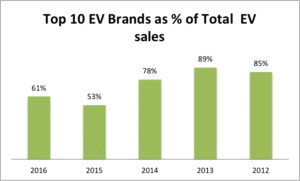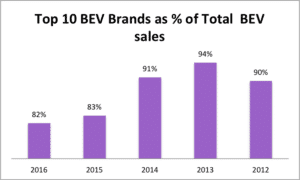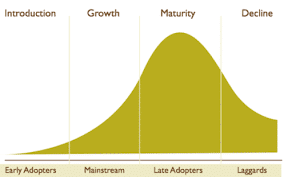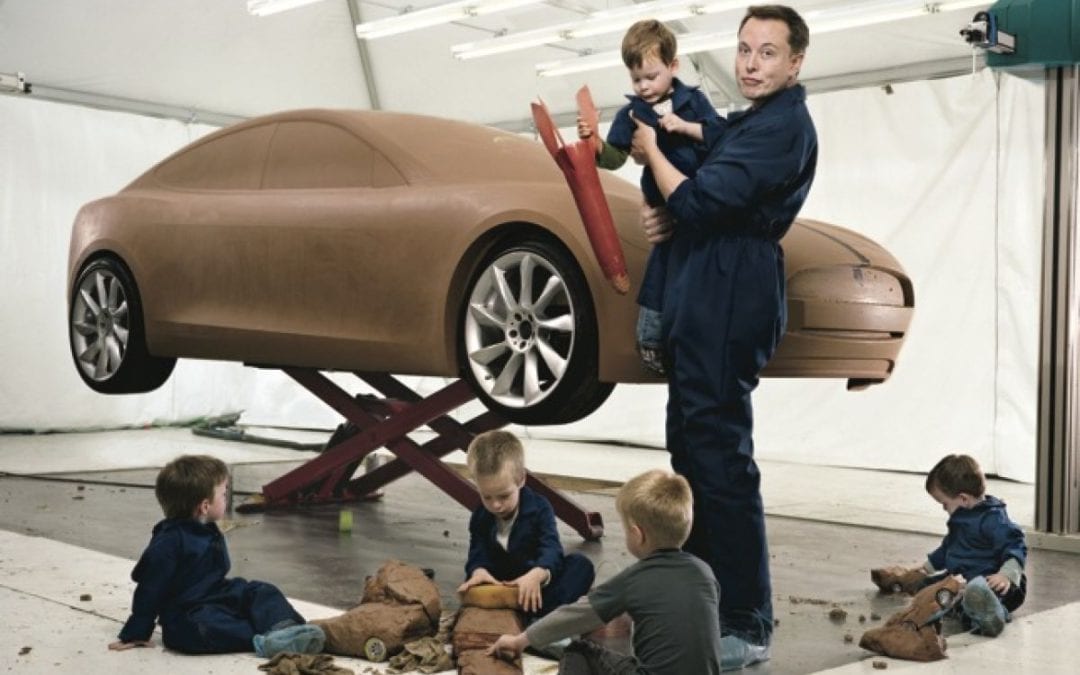Analyzing the Top 10 Electric Vehicle Brands
Electric vehicle sales have breached the 2 million unit mark internationally in 2016, and most automakers have committed to an electric vehicle strategy, some more aggressive than others and in the minority of cases not having a strategy is also seen to be a strategy. The Top 10 Electric Vehicle Brands constitutes a good proxy to evaluate trends within the market and to determine the reason for a brand’s success or failure. Also, as we reach the halfway mark to the point where electric vehicles are expected to reach between 9% and 11% of the total vehicle fleet by 2025, a look into the Top 10 will provide guidance on the expected winners and losers as the disruptive nature of the technology takes effect.
Top 10 Electric Vehicle Brands as a percentage of the total market


Sales of the Top 10 Electric Vehicle Brands constitute 65% of all electric vehicle (EV’s) sales, and for the Top 10 BEV list, 85% of all pure electric or Battery Electric Vehicles (BEV’s) are from the Top 10 Brands in the segment. However, the trend on both lists is on the decline as more and more brands participate in the market. The Top 10 Brands in the pure electric space owns a bigger percentage of the market segment as BEV’s requires more specialization and greater risk. Due to the high cost of battery technology and range anxiety, most automakers excluded themselves from the pure electric segment, providing a golden opportunity for a few dedicated brands to seize the opportunity and leapfrog their competitors into the coming decade.
Top 10 Plug-In Electric Vehicle Brands

The following interesting point emerges when comparing the Top 10 Electric Vehicle Brands positions in 2012 with the overall standings and the latest standings in 2016:
- Chevrolet’s annual sales in 2016 are only marginally higher (1.7% CAGR) than it’s sales back in 2012, while the automaker nearly lost its position on the Top 10 list, regaining some stature in 2016 through a nearly doubling of its Chevrolet Volt sales.
- Nissan remained successful with its only passenger model, the Nissan Leaf while sales of the commercial van, the e-NV200 only amounts to around 8,500 units internationally. Having only one model over the period, however, cost the automaker its overall top spot to Tesla and BYD who had two models or more with multiple configurations.
- Tesla’s overall position is significant, especially if one take into consideration the price point of its models compared to its competitors on the Top 10 list.
- The rise of Tesla and BYD, being of the few companies which only focus on electric vehicles, goes to show the advantage dedicated and focussed EV manufacturers have over those that are tied to combustion vehicles. Both these companies are now busy with second and third generation products going into the third decade of the century, at a time when most competitors will only bring their first pure electric models to market.
- Toyota has been the disappointment on the list, giving up the first-mover advantage it had with the Toyota Prius. Toyota is one of the automakers who’s strategy veered away from electric vehicles to Fuel Cell Vehicles. The company discontinued its Prius model in 2015 and brought it back in 2017, with hardly any significant increase in battery performance.
- BMW’s strategy to early on bring Plug-in Hybrid versions off most of its models has helped the company climb in the rankings. Most of the sales of the German automaker can be attributed to the BMW i3 and BMW i3REx of which the company sold around 70,000 units internationally.
- Ford is the other disappointing manufacturer, with the company completely disappearing off the list, even with two PHEV models and one BEV in its stable. The biggest reason for Ford’s disappointing performance is its lack of international sales outside of the USA and Canada.
- Renault also lost in the rankings despite having various models due to limited international sales.
- The Chinese dominance is evident from the number of Chinese-based auto manufacturers entering the list in 2016, with top performer BYD claiming the top spot in 2015 and 2016, taking the company to an overall third position. BYD’s success also proves Warren Buffets mastery, as the world’s second richest man invested in BYD back in 2008.
- Note – The 2017 data is skewed with underperforming Chinese sales in January due to the Chinese New Year and the Chinese government clamping down on subsidy fraud. The 2017 data is further skewed with the inclusion of USA, Swedish, Norwegian and Dutch sales for February and only some countries January data being available at the time of going to press.
Top 10 Battery Electric Vehicle Brands

Looking at the Top 10 Electric Vehicle Brands list when one only include Battery Electric Vehicles an entirely different picture emerges in many respects:
- Most of the traditional “Big Auto” brands are missing from the list.
- Chinese manufacturers, BYD, BAIC, Zotye, Chery, Kandi, JMC, and JAC, comprise six out of the Top 10 overall positions and seven of the Top 10 in 2016.
- The Top 3 BEV manufacturers in 2016 correspond to the Top 3 overall for all EV’s sold in the previous table, confirming the importance of focussing on BEV’s.
- VW has committed to a strategy shift towards electric vehicles, but it is evident judging from the 2016 data that the company needs to make hay not to fall short.
Electric Vehicles are entering the growth market phase in some countries
With EV sales rapidly climbing in 2016 and countries such as Norway now reaching EV sales of over 30% of new vehicles, owning an EV is not just an environmental requirement anymore drawing early adopters. Owning an EV’s has become cool and entering the growth phase in markets such as Norway and The Netherlands, where a couple of “Big Auto” manufacturers have opted to target the mainstream market through bringing Plug-In Hybrid versions of existing models. Many of the “Big Auto” brands are play stalling tactics by calling for the easing of emission standards or blocking Tesla’s direct sales model. Meanwhile, they are falling further and further behind in a market that is becoming ever more popular. Most of these manufacturers might be of the  opinion to follow a wait and see approach, hoping that the first mover’s trips and falls due to the high risk and cost, with the intention to swoop in later with their big budgets to poach talent and ideas. We will analyze the tussle between Battery Electric Vehicles and Plug-in Hybrid Electric Vehicles in a follow-up post.
opinion to follow a wait and see approach, hoping that the first mover’s trips and falls due to the high risk and cost, with the intention to swoop in later with their big budgets to poach talent and ideas. We will analyze the tussle between Battery Electric Vehicles and Plug-in Hybrid Electric Vehicles in a follow-up post.
Picture Ellon Musk: The New Yorker

